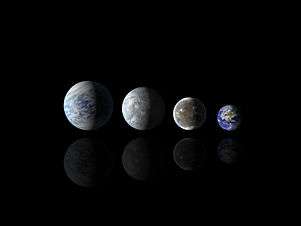Kepler-65
| Observation data Epoch J2000 Equinox J2000 | |
|---|---|
| Constellation | Lyra |
| Right ascension | 19h 14m 45.2920s[1] |
| Declination | +41° 09′ 04.207″[1] |
| Apparent magnitude (V) | 11.018 |
| Characteristics | |
| Astrometry | |
| Proper motion (μ) | RA: 0.970±0.056[1] mas/yr Dec.: −14.189±0.056[1] mas/yr |
| Parallax (π) | 3.2638 ± 0.0289[1] mas |
| Distance | 999 ± 9 ly (306 ± 3 pc) |
| Details | |
| Mass | 1.25 M☉ |
| Radius | 1.41 R☉ |
| Temperature | 6211 K |
| Metallicity [Fe/H] | +0.17 dex |
| Rotation | 7.911±0.155 days[2] |
| Other designations | |
| Database references | |
| SIMBAD | data |
| KIC | data |
Kepler-65 is a star slightly more massive than the Sun and has at least three planets.
Planetary system
Three planets were announced in 2013. All three planets orbit very close to their star. Follow-up radial velocity measurements provided data too noisy to constrain the mass of planets.[4] Follow-up transit-timing variation analysis helped to measure the mass of Kepler-65d which revealed that it has significantly lower density than Earth.[5]
| Companion (in order from star) |
Mass | Semimajor axis (AU) |
Orbital period (days) |
Eccentricity | Inclination | Radius |
|---|---|---|---|---|---|---|
| b | — | 0.035 | 2.154910 | — | 79.07° | 1.42 R⊕ |
| c | <20 M⊕ | 0.068 | 5.859944 | — | 83.65° | 2.58 R⊕ |
| d | 2 M⊕ | 0.084 | 8.131146 | — | 84.8° | 1.52 R⊕ |
External links
References
- 1 2 3 4 5 Brown, A. G. A.; et al. (Gaia collaboration) (August 2018). "Gaia Data Release 2: Summary of the contents and survey properties". Astronomy & Astrophysics. 616. A1. arXiv:1804.09365. Bibcode:2018A&A...616A...1G. doi:10.1051/0004-6361/201833051. Gaia Data Release 2 Vizier catalog entry
- ↑ McQuillan, A.; Mazeh, T.; Aigrain, S. (2013). "Stellar Rotation Periods of The Kepler objects of Interest: A Dearth of Close-In Planets Around Fast Rotators". The Astrophysical Journal Letters. 775 (1). L11. arXiv:1308.1845. Bibcode:2013ApJ...775L..11M. doi:10.1088/2041-8205/775/1/L11.
- ↑ "Kepler-65". SIMBAD. Centre de données astronomiques de Strasbourg. Retrieved 10 January 2017.
- ↑ Asteroseismic determination of obliquities of the exoplanet systems Kepler-50 and Kepler-65: W. J. Chaplin, R. Sanchis-Ojeda, T. L. Campante, R. Handberg, D. Stello, J. N. Winn, S. Basu, J. Christensen-Dalsgaard, G. R. Davies, T. S. Metcalfe, L. A. Buchhave, D. A. Fischer, T. R. Bedding, W. D. Cochran, Y. Elsworth, R. L. Gilliland, S. Hekker, D. Huber, H. Isaacson, C. Karoff, S. D. Kawaler, H. Kjeldsen, D. W. Latham, M. N. Lund, M. Lundkvist, G. W. Marcy, A. Miglio, T. Barclay, J. J. Lissauer
- ↑ https://arxiv.org/abs/1310.7942
This article is issued from
Wikipedia.
The text is licensed under Creative Commons - Attribution - Sharealike.
Additional terms may apply for the media files.


